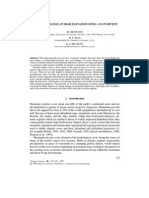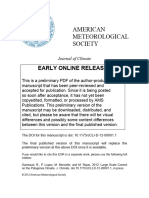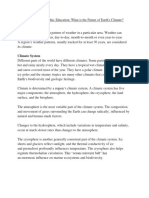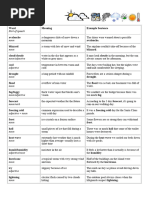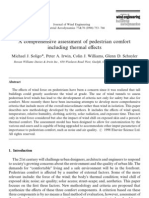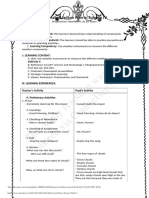Week 2 Reading Material 2
Week 2 Reading Material 2
Uploaded by
uapsa.mapua.doroteoCopyright:
Available Formats
Week 2 Reading Material 2
Week 2 Reading Material 2
Uploaded by
uapsa.mapua.doroteoCopyright
Available Formats
Share this document
Did you find this document useful?
Is this content inappropriate?
Copyright:
Available Formats
Week 2 Reading Material 2
Week 2 Reading Material 2
Uploaded by
uapsa.mapua.doroteoCopyright:
Available Formats
Climate Zones
Background Information for Teachers
Classifying Climate
The Köppen-Geiger classification system is the most commonly used system for
categorizing climates. It divides the world into five main climate groups depending on the
seasonal temperature and precipitation patterns: A (tropical), B (dry), C (temperate), D
(continental) and E (polar). Because it takes into account not only annual temperature
and precipitation patterns but also the annual cycles of both, it is usefully linked to biome
distribution.
Beck, H.E., Zimmermann, N. E., McVicar, T. R., Vergopolan, N., Berg, A., & Wood, E.
F. - "Present and future Köppen-Geiger climate classification maps at 1-km
resolution". Nature Scientific Data. DOI:10.1038/sdata.2018.214. CC BY 4.0
More for Teachers – Climate Zones
A world map showing the countries classified according to Köppen-Geiger classification
but resized according to the population size of the country. This clearly shows which
climate types support the greatest populations.
The climate zones themselves are closely linked to the Global Atmospheric Circulation
(see chapter 4).
For a full definition of the classification system see, for example,
https://en.wikipedia.org/wiki/Köppen_climate_classification
More for Teachers – Climate Zones
Focussing on the 5 main groups with the addition of a Mountain category, the diagram
can be simplified into:
© Crown copyright, Met Office
Tropical
Tropical or Equatorial climates are home to the world's rainforests, where rainfall and
humidity are high. Temperatures are generally 25-35 °C and vary little through the year.
Dry
The dry or arid regions are linked to the High pressure, cloud free belts at the edges of
the Hadley cells. Cold ocean currents can contribute to reduced availability of rainfall.
The temperature range in sub-tropical deserts can be large, regularly exceeding 45 °C by
day in summer and often falling to below freezing overnight in winter.
Mediterranean
Mediterranean climates vary seasonally and are linked to the descending air at the edges
of the Hadley cells in summer and to the westerlies of the Ferrel cells in winter. This
gives hot dry summers and cooler, wetter winters.
More for Teachers – Climate Zones
Continental
Far from the ameliorating effect of the oceans, continental climates are characteristic of
the interior of large land masses of mid latitudes; the main distinguishing features are
large annual and diurnal ranges of air temperature and low rainfall.
Polar
Linked to the Polar Cell, polar climates can be subdivided into Tundra and ice cap/ frost
depending on whether the mean temperature of the warmest month is above or below
0°C. The Arctic climate is moderated by the relatively warm Atlantic Ocean. In the
Antarctic, the distance from the ocean and a source of water vapour can mean that it is
truly too cold to snow.
Temperate
Temperate climate zones lie between the tropics and the polar circles in the westerlies of
the Ferrel cell. The changes in these regions between summer and winter are generally
subtle, warm or cool, rather than extreme, burning hot or freezing cold, but all temperate
regions have four distinct seasons. However, a temperate climate can have very highly
variable weather. One day it may be sunny, the next it may be raining. Temperate
climate can have a maritime influence.
Climate Zones and Climate Change
Whereas climate change will not mean that that all the climate zones will simply shift
polewards, they will of course change with a changing climate. Large shifts in the global
distribution of Köppen-Geiger climate zones have been projected by the end of the
century.
More for Teachers – Climate Zones
Pace of Shifts in Climate Regions Increases with Global Temperature Figure 2, 2013,
Mahlstein et al. DOI: 10.1038/NCLIMATE1876. This graph does not show whether the
location of these climates has shifted over the globe.
A 2013 paper in Nature Climate Change suggested that for the initial 2°C of warming,
about 5% of Earth's land area shifts to a new climate zone. The rate at which climate
zones shift is about the same as the rate at which global temperatures increase – both of
which are projected to become more rapid.
The paper predicted that over the 21st Century
- Frost climates largely decrease
- Some arid regions increase
- A large fraction of land area changes from cool summers to hot summers
- Most northern mid-latitudes and polar latitudes undergo climate zone shifts
- There is less change in tropical regions, except in mountain regions where there
are projected changes in precipitation.
The scientists also suggested that temperature changes have a greater impact on
climate zone changes than precipitation changes.
The lead author, Mahlstein, said "A shift in the climate zone is probably a better measure
of 'reality' for living systems, more so than changing temperature by a degree or
precipitation by a centimetre". As the speed of climate zone shift increases, the ability of
species to adapt reduces and more extinctions can be expected.
Further reading: https://e360.yale.edu/features/redrawing-the-map-how-the-worlds-
climate-zones-are-shifting
More for Teachers – Climate Zones
Some climate zones – particularly semi-arid ones, have been designated climate change
hot spots. These so-called “hotspots” are areas where strong physical and ecological
effects of climate change come together with large numbers of vulnerable and poor
people and communities.
Making SDGs work for climate change hot spots, Szabo et al, 2016, Sourced from
https://www.tandfonline.com/doi/full/10.1080/00139157.2016.1209016?journalCode=venv20&scroll=top&ne
edAccess=true
Sources of Information
Climate data https://en.climate-data.org
Global maps of vegetation and climate https://earthobservatory.nasa.gov/global-maps
Full climate graphs and other information for the climate zones may be found at
https://www.metoffice.gov.uk/binaries/content/assets/metofficegovuk/pdf/research/library-
and-archive/library/publications/factsheets/factsheet_16-world-climates.pdf
More for Teachers – Climate Zones
You might also like
- 01 Hartmann Global Physical Climatology 2nd - Ed Páginas 7 29Document23 pages01 Hartmann Global Physical Climatology 2nd - Ed Páginas 7 29ElizabethCastañedaHernandez100% (2)
- 6 What Factors Affect ClimateDocument6 pages6 What Factors Affect ClimateSandeep Singh100% (1)
- Chart For Calculation of Relative Humidity & Dew Point: Dry Bulb Temp ºCDocument2 pagesChart For Calculation of Relative Humidity & Dew Point: Dry Bulb Temp ºCAnonymous tvxyDjoNo ratings yet
- Climate ClassificationDocument6 pagesClimate ClassificationMarky CieloNo ratings yet
- Tropical Climates Are Characterized by High TemperaturesDocument2 pagesTropical Climates Are Characterized by High TemperaturesbharmkidumpNo ratings yet
- ClimateDocument7 pagesClimateMuhammad AminNo ratings yet
- Module-4-Types-of-ClimatesDocument53 pagesModule-4-Types-of-ClimatesClark KentNo ratings yet
- World Climate: Dr. R. B. SchultzDocument18 pagesWorld Climate: Dr. R. B. SchultzA.f. HamdaNiNo ratings yet
- Climate SystemDocument11 pagesClimate SystemFaisal ShafiqueNo ratings yet
- ClimateDocument43 pagesClimateGabby VNo ratings yet
- Climate Classification: Agronomy 541: Lesson 8aDocument50 pagesClimate Classification: Agronomy 541: Lesson 8ayasahswi91100% (1)
- Unit Two 2Document3 pagesUnit Two 2abukiahmed07No ratings yet
- Science ReportDocument1 pageScience ReportJhoana S. BargayoNo ratings yet
- Climate Classification PDFDocument12 pagesClimate Classification PDFAndrea Louise VergelNo ratings yet
- The World Climate ZoneDocument12 pagesThe World Climate ZoneChrisNo ratings yet
- climate and elements of weatherDocument18 pagesclimate and elements of weathermaemuhatiaNo ratings yet
- Geo-10-Unit-Two @SSC (1)Document8 pagesGeo-10-Unit-Two @SSC (1)Mequanent MengistuNo ratings yet
- Environment ManagementDocument11 pagesEnvironment ManagementbillatonyNo ratings yet
- Köppen-GeigerDocument2 pagesKöppen-Geigerjhcheon411No ratings yet
- Geo SelectedDocument27 pagesGeo Selectedtted3718No ratings yet
- Final NatscieclimateDocument3 pagesFinal NatscieclimateFebe NievaNo ratings yet
- KoeppenDocument8 pagesKoeppenanjuNo ratings yet
- Geography PresentationDocument6 pagesGeography Presentationtemeyot148No ratings yet
- Meteorology-Chapter 17-Climate DynamicsDocument6 pagesMeteorology-Chapter 17-Climate DynamicsMorales, Jerome R.No ratings yet
- Ecological Choice Describing Climate 20190601Document27 pagesEcological Choice Describing Climate 20190601Alex SupertrampNo ratings yet
- ClimateDocument11 pagesClimateLoeren CaronanNo ratings yet
- Pampa & AbdullahDocument6 pagesPampa & AbdullahFatimah Sohra PampaNo ratings yet
- Climate Change and Its ImpactDocument6 pagesClimate Change and Its ImpactFatimah Sohra PampaNo ratings yet
- Climatic Change at High Elevation Sites: An OverviewDocument19 pagesClimatic Change at High Elevation Sites: An OverviewYulya BagriyNo ratings yet
- The World Climate Refers To The LongDocument2 pagesThe World Climate Refers To The LongTg GhabhyNo ratings yet
- Garreaud 2013Document49 pagesGarreaud 2013Juanita ValleNo ratings yet
- Climate Change QuesDocument26 pagesClimate Change QuesA.JONAH ELISA SHINYNo ratings yet
- Architectural Design Based On Climatic DataDocument14 pagesArchitectural Design Based On Climatic DataKukishin KrimNo ratings yet
- Climate ZonesDocument7 pagesClimate ZonesJhemhicis BielzaNo ratings yet
- Climatology and World WeatherDocument30 pagesClimatology and World Weathermahadi972002No ratings yet
- Tropicak Glaciers PDFDocument13 pagesTropicak Glaciers PDFAlexandra CassasNo ratings yet
- What Is ClimateDocument15 pagesWhat Is Climatecourtneychikumbo47No ratings yet
- BARNETT Et Al. 2005 - Potential Impacts of A Warming Climate On Water Availability in Snow-Dominated RegionsDocument7 pagesBARNETT Et Al. 2005 - Potential Impacts of A Warming Climate On Water Availability in Snow-Dominated Regionsdescarga2012No ratings yet
- 4 - 1 - Koppen Climate Classification SystemDocument6 pages4 - 1 - Koppen Climate Classification Systemzoafanai033No ratings yet
- 3. Climate (1)Document39 pages3. Climate (1)Rime BouNo ratings yet
- BST161 1.0 - ClimateDocument48 pagesBST161 1.0 - ClimateNuriy NabihahNo ratings yet
- 201hansen - Et Al (2012) Perception of Climate ChangeDocument12 pages201hansen - Et Al (2012) Perception of Climate ChangeclarklipmanNo ratings yet
- Lenton - Nature Comment - Accepted - VersionDocument7 pagesLenton - Nature Comment - Accepted - VersionnurultanjungNo ratings yet
- Science and Art of GeographyDocument4 pagesScience and Art of GeographyMaxpein MoonNo ratings yet
- Seminarski Climate and Climate ChangesDocument13 pagesSeminarski Climate and Climate ChangesAzra RujanacNo ratings yet
- For Module Chapter 5 Final PDFDocument25 pagesFor Module Chapter 5 Final PDFJanjesrey GallanoNo ratings yet
- Global Climate Systems: Geosystems 5eDocument57 pagesGlobal Climate Systems: Geosystems 5eThảo My NguyễnNo ratings yet
- Climate Change: Frequently Asked QuestionsDocument8 pagesClimate Change: Frequently Asked QuestionsAdriano Racho MelendresNo ratings yet
- Factors That Affect Climate St. Simon 2Document27 pagesFactors That Affect Climate St. Simon 2Juvielyn Raz100% (1)
- Factorsthataffectclimate 7Document20 pagesFactorsthataffectclimate 7Juvielyn RazNo ratings yet
- Climate Change (Reviewer)Document12 pagesClimate Change (Reviewer)Keziah PepitoNo ratings yet
- Weather & ClimateDocument38 pagesWeather & Climatejenjang yannie100% (1)
- Intl Journal of Climatology - 2020 - Imfeld - A Combined View On Precipitation and Temperature Climatology and Trends inDocument20 pagesIntl Journal of Climatology - 2020 - Imfeld - A Combined View On Precipitation and Temperature Climatology and Trends inAndy GarcíaNo ratings yet
- Climate Change: 6.1 Causes and ImpactsDocument13 pagesClimate Change: 6.1 Causes and ImpactsBipin AdhikariNo ratings yet
- Climate, Classification, Philippine Climate Final VersionDocument38 pagesClimate, Classification, Philippine Climate Final Versionaprildina.loquinteNo ratings yet
- ClimateDocument8 pagesClimatedilhanthausjpNo ratings yet
- All Notes Climatology_081704Document112 pagesAll Notes Climatology_081704nefer1336No ratings yet
- Learning About Biodiversity March 2011 Page 2Document1 pageLearning About Biodiversity March 2011 Page 2veldfloraedNo ratings yet
- Angl ADocument5 pagesAngl Akirikuja23100% (1)
- Global WarmingDocument6 pagesGlobal Warmingapi-245872444No ratings yet
- Creating A Climate GraphDocument31 pagesCreating A Climate GraphJannelle McCulloughNo ratings yet
- Harmonoise - Noise Predictions and The New European Harmonised Prediction ModelDocument7 pagesHarmonoise - Noise Predictions and The New European Harmonised Prediction ModelOmar PugaNo ratings yet
- Physiography of Lakes and Reservoirs - Mixing Regimes and Water MovementDocument4 pagesPhysiography of Lakes and Reservoirs - Mixing Regimes and Water MovementSalemGoodsNo ratings yet
- Climatology 2 PDFDocument14 pagesClimatology 2 PDFumashankaryaligarNo ratings yet
- Aviation Weather MeteorologyDocument40 pagesAviation Weather MeteorologyChouaib Ben BoubakerNo ratings yet
- University Institute Architecture: Bachelor of Architecture Subject Name: CLIMATOLOGY Subject Code: ART-226Document40 pagesUniversity Institute Architecture: Bachelor of Architecture Subject Name: CLIMATOLOGY Subject Code: ART-226Mohit DhimanNo ratings yet
- Geography Lesson 4 AssignmentDocument3 pagesGeography Lesson 4 AssignmentAnanya MagarNo ratings yet
- 0 - Actions On Structures Wind Loads - CIB ReportDocument100 pages0 - Actions On Structures Wind Loads - CIB ReportWilliam PolNo ratings yet
- Kees Stigter (Auth.), Kees Stigter (Eds.) - Applied Agrometeorology-Springer-Verlag Berlin Heidelberg (2010) - Compressed-1-Compressed-1-250Document250 pagesKees Stigter (Auth.), Kees Stigter (Eds.) - Applied Agrometeorology-Springer-Verlag Berlin Heidelberg (2010) - Compressed-1-Compressed-1-250Gabriel Luan RodriguesNo ratings yet
- XI SMK - Modul 1 Materi SMT 4Document5 pagesXI SMK - Modul 1 Materi SMT 4Rendy Saputra100% (1)
- Grade 9 The Canadian Atlas Online - WeatherDocument9 pagesGrade 9 The Canadian Atlas Online - Weathermcmvkfkfmr48gjNo ratings yet
- Vocabulary Weather B2Document2 pagesVocabulary Weather B2Filip RakocevicNo ratings yet
- Rain 1Document7 pagesRain 1velpt2004No ratings yet
- Geography Class WorkDocument3 pagesGeography Class WorkIsraelNo ratings yet
- HTTP WWW - Sciencedirect.comDocument14 pagesHTTP WWW - Sciencedirect.comapi-19757021No ratings yet
- Typhoon Rai Odette - DTM Report 3 - 28 Mar 2022Document12 pagesTyphoon Rai Odette - DTM Report 3 - 28 Mar 2022HadiaNo ratings yet
- Meteorology NotesDocument26 pagesMeteorology NotesdaveNo ratings yet
- Geography Project - Grade 9 Term I 2022-23Document2 pagesGeography Project - Grade 9 Term I 2022-23heetpatel2008No ratings yet
- TNPSC Weather ClimateDocument34 pagesTNPSC Weather ClimateAnand S100% (1)
- IP-17 - Thermal Comfort StandardsDocument8 pagesIP-17 - Thermal Comfort Standardsjgam_91No ratings yet
- SECOND QUARTER EXAM Science 8Document5 pagesSECOND QUARTER EXAM Science 8Melanie B. GenerosaNo ratings yet
- Cyclones - Distribution and CausesDocument21 pagesCyclones - Distribution and CausesChaos InsurgencyNo ratings yet
- Nuclear StandardsDocument39 pagesNuclear StandardsChandima GomesNo ratings yet
- Geophysics BrochureDocument11 pagesGeophysics BrochureAmit RaiNo ratings yet
- This Study Resource Was: A Detailed Lesson Plan in Science IVDocument7 pagesThis Study Resource Was: A Detailed Lesson Plan in Science IVAlexis De LeonNo ratings yet
- Asd BlocklevelfrctDocument45 pagesAsd BlocklevelfrctSri SravaniNo ratings yet
- Grade 10 Geo JIT 2024 Learner DocumentDocument75 pagesGrade 10 Geo JIT 2024 Learner DocumentmbenguzanakNo ratings yet




























